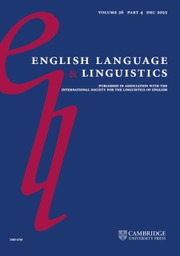No CrossRef data available.
Article contents
Positional spelling redistribution: word-initial <u>/<v> and <i>/<j> in Early Modern English (1500–1700)
Published online by Cambridge University Press: 06 November 2020
Abstract
The alternations in <u>/<v> and <i>/<j> are among the most well-known and commented-upon changes in Early Modern English spellings, yet little has been said about the potential factors underlying their standardisation, and whether and how the two alternant pairs could be linked together. The reason behind this knowledge gap may be found in the absence of a large-scale, quantitative investigation of these spellings, and consequently, the impossibility of commenting upon the relationship between patterns of chronological development and potential causes of change. This article focuses on the standardisation of word-initial <u>/<v> and <i>/<j> between 1500 and 1700 in printed English, and uses a quantitative model for the analysis of patterns of diachronic development in the two alternant pairs, across a range of texts from a sampled version of Early English Books Online. The results describe a rather abrupt, synchronised change in the redistribution of word-initial <u>/<v> and <i>/<j> between the 1620s and the 1640s. The discussion argues for a close connection between the diachronic developments in word-initial <u>/<v> and <i>/<j>, and pragmatic factors that affected the Early Modern English printing industry.
Information
- Type
- Research Article
- Information
- Copyright
- Copyright © The Author(s), 2020. Published by Cambridge University Press


